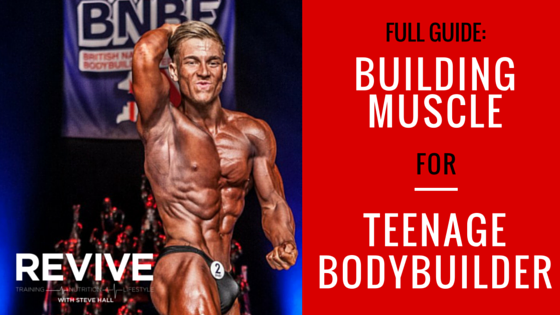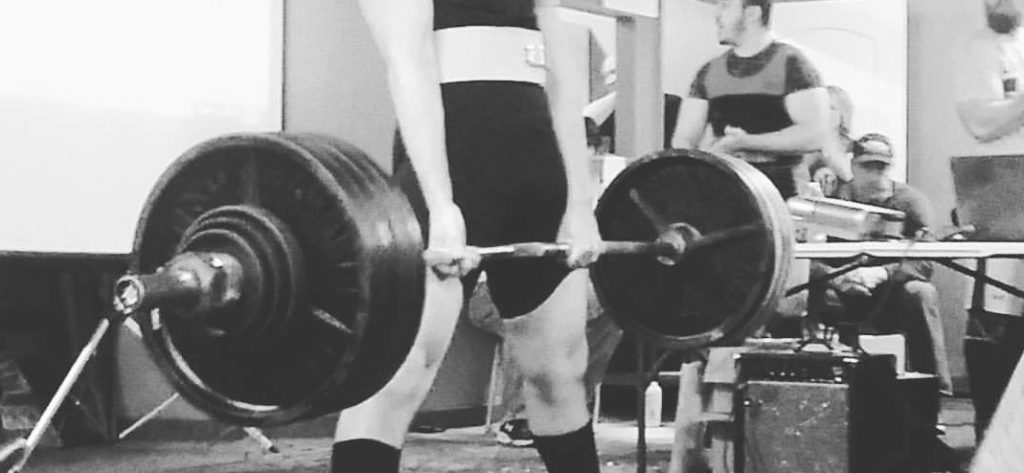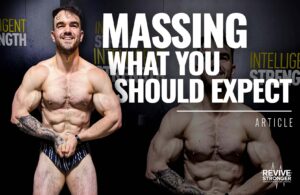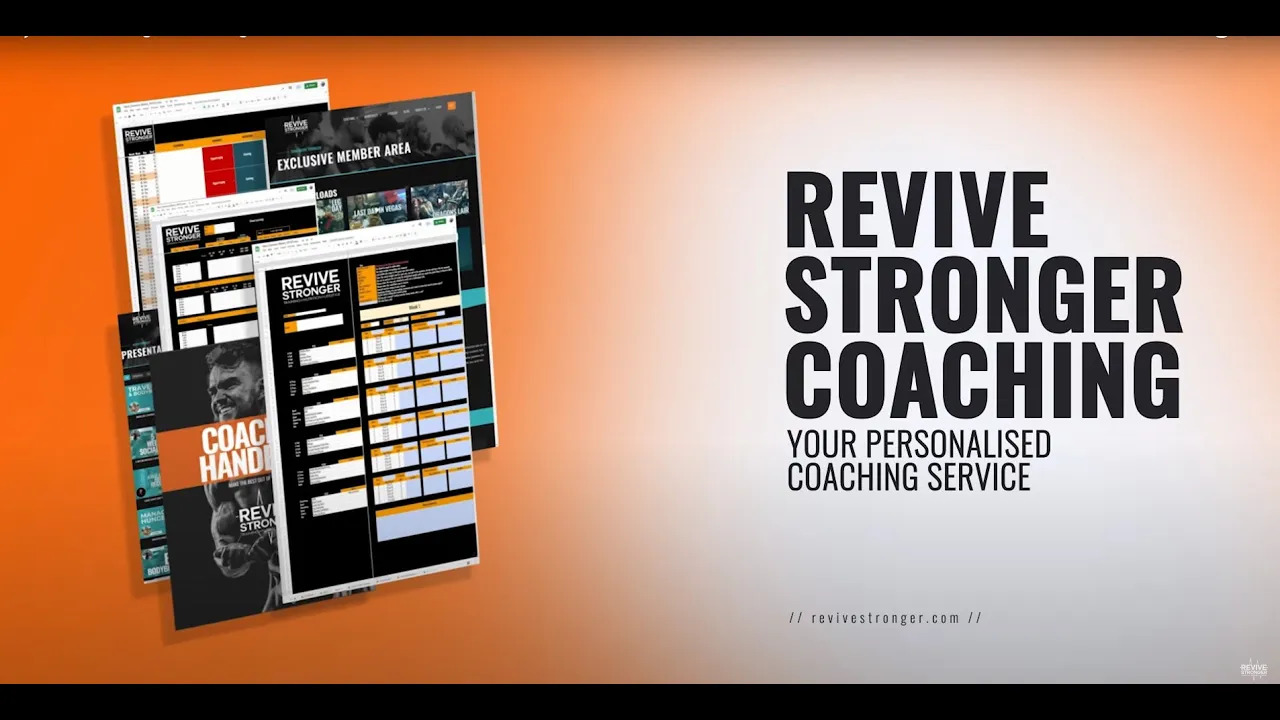
Revive Stronger
Full Guide: Building Muscle for the Teenage Bodybuilder

Hey Guys I want to introduce to you my pal and fellow Natural Bodybuilder and Personal Trainer; AJ Morris from the UK (pictured above).
AJ got into the gym through spending his younger years competing in motor-sport and fitness was a fundamental part in becoming the best racing driver possible. AJ was lucky enough to transfer this passion into competing in bodybuilding and eventually changing his career path, by becoming a Personal Trainer.
AJ is going to take you through how he trained to gain muscle as a teenager, and is going to give you some practical tips to help you gain more muscle.
I’ve done things the right way and I’ve done things the wrong way.
Gaining muscle doesn’t have to be as hard or as complex as you think it is.
In reality, it’s pretty simple
– damn, it’s even easier when you are younger.
By the end of this article you will have learn how to gain muscle as a teenager.
Table of Contents
Training for the Teen Bodybuilder
We are lucky enough to live in an age where there is SO much information flooding the internet about the latest training approaches, new and exciting methods that can yield more gains than you’ve ever had before.
However, it’s not doing you any good.
[bctt tweet=”There is so much fitness information out there & it isn’t helping you”]
Problem is, there is so much information – as a teen we can be impatient, wanting things to come quicker than they should.
We want results now.
So when the latest and greatest new training method is released, we all change over from our current programme, to another one, in the search for more gains.
But is this really what you should be doing?
Let’s talk about ‘Your Optimal’
It’s all well and good finding a programme that has worked well for others.
However, it might not work well for you.
An optimal training programme for you, is the one you can stick to, which means it:
- Needs to fit your lifestyle.
- Needs to be enjoyable.
To stay on track and make progress to gaining the muscle that you so avidly want, you will have to be somewhat consistent.
Consistency will breed in a programme that you can stick to over a long period of time, and you won’t stick to a programme you don’t enjoy; hence why those become your top two factors.
[bctt tweet=”you won’t stick to a programme you don’t enjoy”]
Finding your ‘Optimal’
It’s been shown that training body part with a 2-3x per week frequency is going to be optimal for hypertrophy. [1]
I am going to present two options that are going to cater for that, whilst fitting your lifestyle and being something you enjoy.
Option 1: Upper/Lower
Who is it for: Less Time, Less Dedicated, Newer To Weight Training.
You like training, you are in usually 3 – 4 times a week…
But you have weeks where you slip up, you miss workouts, you go out on a Friday and are too hungover to train your legs over the weekend.
You only train twice instead of 4 times.
This is where an Upper Lower split can do you a massive favour. If you were training only one body part per session, and you managed to only fit in two during the week, you’ve only trained two body parts….
You’ll see slow progress and you won’t have trained your entire body.
Planning to only hit the gym two times per week?
But still want to achieve 2-3x per week frequency?
Two full body workouts is your answer – simply reduce overall volume by removing a set from each exercise or drop the accessory work, and combine your upper and lower workouts.
That’s not much to ask if you are really trying to gain some muscle – you will be able to still get homework completed, go out with your friends, spend time with family whilst gaining muscle in a balanced, proportional manner.
How would I plan out an Upper Lower Split?
As mentioned above, it’s important that you enjoy the exercises you pick – find some that you really enjoy and can see yourself using for a long period of time.
Please Note – you don’t HAVE to perform several accessory movements, you could simply focus on a compound movement and have a few accessories including body parts that you particularly want to bring up. The idea is, you balance your training and choose movements you enjoy doing, your sessions shouldn’t take you ages to complete, hence why we place an emphasis on compound movements, to get a lot more ‘bang for your buck’ in terms of muscles used.
Option 2 Push/Pull/Legs
Who is it for: More Time, More Dedicated, More experienced with Weight Training.
Ok so you have more time, less commitments, maybe you don’t like going out drinking on a Friday Night.
You want to train more frequently than 4 times per week and you are searching for a program to situate that. Upper Lower is possible, but it’s more than likely that you’d be absolutely knackered by the time a rest day comes around.
Push/Pull/Legs/Rest/Repeat comes into play.
Before I start, you don’t HAVE to do push pull legs in that order, you can mix it around to suit how you’d like to train, Pull Push Legs is a common way to switch things up, allowing for the Deadlift to be trained on the Pull days.
I personally have used this split for a long time and made great progress.
How would you plan out a Push Pull Legs Split?
Let’s make it simple:
- Push Day – Bench Press/OHP & 1 – 2 Chest, Delt and Tricep Accessory Movements.
- Pull Day – Bent Over Row & 2 Back Accessory Movements, 2 Bicep Accessory Movements.
- Legs Day – Squat/Leg Press, Hip Hinge (Deadlift variety) & 1 Accessory Movement for the Quads & Hamstrings, 1 Calf Accessory Movement.
Don’t go adding more and more accessory movements each week, find a balance that works for you and that you can fit into your busy lifestyle.
If you set yourself up with a program that you will not have time to complete, you are setting yourself up for failure.
[bctt tweet=”Train in a way that you enjoy & can stick to”]
Aim to start WINNING early on by setting up a training program that you can stick to for a long time.
What about Reps, Sets And Rest?!
You are probably wondering how many sets and reps you should be doing.
Make it simple:
- Have a higher rep day.
- Have a lower rep day.
Compound Rep Range:
- Hypertrophy Days: 8 – 12 Reps
- Power Days: 5 – 8 Reps
Accessory Rep Range
- Hypertrophy Days: 10 – 15 Reps
- Power Days: 8 – 12 Reps
Aim for 3 – 4 working sets on a compound movement and 2 – 3 working sets on an isolation movement.
The higher the rep range, the lower the sets can be.
What about rest periods? Don’t stress, just go by feel, if you feel ready to go again, lift – read more here.
[bctt tweet=”Build the foundation with the basics.”]
Progression
I think you can agree the above is fantastic, I love the emphasis AJ puts on making the workout fit your lifestyle and something you enjoy — because in the end this will determine whether or not you are consistent.
Now I just want touch on a simple way to progress in the workouts AJ has provided.
Progressive overload is absolutely vital when it comes to growing muscle.
So we’d be silly not to strive for progression, and as a teenage bodybuilder you can progress at a good rate. Likely you can even increase your reps and or weight used every week, and if you can, great, you should strive to do this.
A simple way to programme progression:
- Have a rep range and set range e.g. 2 to 3 sets of 8 to 10 reps
- Start with the lower range on each.
- Once you can achieve the lower set range for the higher rep range, add a set.
- Once you can achieve the higher set and rep range, add load.
- Now go back to the lower set and rep range, and rinse and repeat the above.
An example:
Week 1: Squat – 100kg x 8, 8
Week 2: Squat – 100kg x 10, 8
Week 3: Squat – 100kg x 10, 10
Week 4: Squat – 100kg x 10, 10
Week 5: DELOAD – Squat 100kg x 4, 4
Week 6: Squat – 100kg x 10, 10, 8
Week 7: Squat – 100kg x 10, 10, 10
Week 8: Squat – 105kg x 8, 8
As you can see over the 8 weeks you have added 5kg to your initial 100kg for 2 sets of 8.
You may progress faster, or even slower than this, as we know progress is not always perfectly linear; it depends on multiple factors — key is that overtime you are progressively using more total load. If you want to learn more about progression read here.
Teenage Bodybuilders Take Note
-
Make sure you enjoy your approach to training.
-
Start with the basics, progress, and SLOWLY add more.
-
Whatever you do, stay consistent!
-
Focus on yourself, do what works for YOU.
-
Have a blast. Building muscle is fun.
WHAT NEXT?
Do you need any help with the above? Do you have any questions you need answering? Are you looking to do a bodybuilding show and need help planning out the details?
Join my free facebook group or add me on snapchat (revivestronger) and ask your question there, I will respond asap.
More from AJ:
- Youtube
- Snapchat – ajmorrisssss
- AJ also has a specific group for young people seeking to drop fat and gain muscle.
If you want to learn more advanced training programming I recommend you read: Phase Potentiation: The Bigger the Base, The Bigger the Peak or if you want to learn how to eat for muscle read: Your Tailor Made Diet
One more thing…
Do you have a friend who is looking to start weight training and wants to gain muscle? Share this article with them and let me know what they think.
[bctt tweet=”Building Muscle as a Teenage Bodybuilder”]
References
- Eric Helms – The Muscle And Strength Pyramid – Training – 2015
We are a personal coaching service that helps you achieve your goals. We want you to become the best version of yourself.








